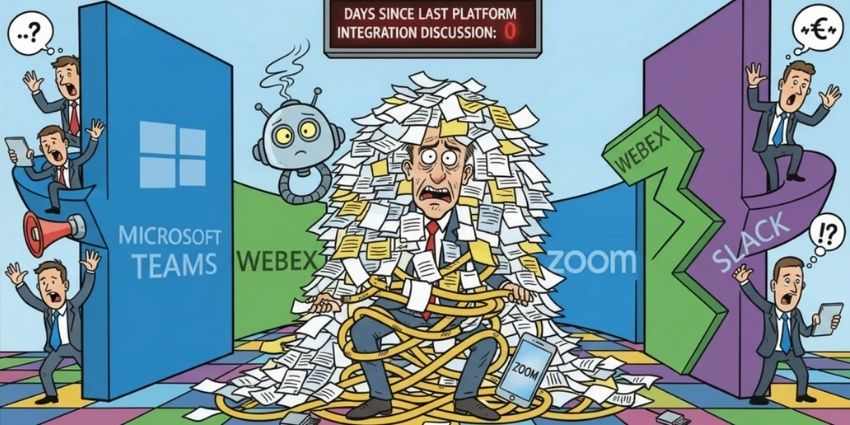In today’s business environment, engagement is currency. Customers have more choice, employees have more mobility, and loyalty can disappear overnight. What keeps those relationships alive is feedback, and how quickly it’s heard and acted upon.
The problem is that most systems collect feedback too late to make a difference. A quarterly NPS report won’t save a customer who’s already switched brands. An annual employee survey can’t stop top performers from walking out the door. These tools measure sentiment, but only after the damage is done.
Closing the loop requires speed. For real-time feedback, CPaaS could be the solution that has previously been overlooked. Once seen as just developer plumbing, CPaaS is now the foundation for engagement infrastructure, connecting voice, SMS, RCS, and chat into live channels for two-way feedback.
A strong CPaaS strategy doesn’t just expand channels but creates a customer feedback loop that closes in minutes, not months, and gives employees a voice through employee engagement APIs built into the flow of daily work.
- The Practical Side of CPaaS Implementation: Overcoming CPaaS Deployment Challenges
- CPaaS Workforce Engagement: Smarter Alerts for Frontline and Deskless Employees
The Engagement Gap: Why Surveys Alone Fall Short
Surveys aren’t the problem. Timing is.
Think about the last time you filled out a customer survey. Chances are, it arrived long after the experience you were asked about. Maybe you clicked a few stars without much thought, or just ignored it. Either way, the insight was stale before anyone on the business side saw it. That’s how entire engagement programs end up chasing shadows.
The risk is obvious in customer experience. PwC found that one in three consumers will abandon a brand after a single bad interaction. Waiting weeks to review a Net Promoter Score won’t bring them back. It plays out just as harshly inside the workforce.
Companies still rely heavily on annual or quarterly engagement surveys. By the time HR teams finish analyzing results, the people most frustrated have often already left. Gallup’s latest data puts global employee engagement at just 21 percent. The number barely changes, year after year, even as employers invest in recognition apps and wellness schemes.
This is why leaders are now looking at real-time feedback CPaaS solutions. Instead of waiting for survey cycles, they can embed short prompts after a transaction, capture frontline sentiment through employee engagement APIs, or trigger a quick RCS or SMS poll as part of routine workflows. In practice, it turns the customer feedback loop from a lagging report into a living system.
Real-Time Feedback: CPaaS as Feedback Infrastructure
For years, CPaaS was dismissed as “just APIs”, the technical plumbing that allowed developers to bolt SMS or voice onto existing systems. Now, CPaaS is becoming the backbone of modern engagement, particularly when it comes to building fast, flexible feedback loops.
At its core, CPaaS enables enterprises to integrate communication directly into workflows. A delivery app can trigger a two-question survey as soon as a package is dropped off. A hospital can send a quick RCS prompt to confirm whether discharge instructions were clear. A logistics firm can capture driver feedback by voice in the middle of a shift, then automatically transcribe and route it into dashboards for managers. None of this requires a separate platform or a lengthy IT rollout; it’s embedded through customer or employee engagement APIs and orchestration layers.
The range of tools is broad.
- Voice bots can capture sentiment in real time, running short pulse checks that feel like conversations rather than forms.
- SMS polls remain a simple yet powerful tool for gathering high-volume, quick-turn feedback.
- RCS and WhatsApp add rich interactivity, verified sender IDs, clickable buttons, and carousels, which drive higher response rates and trust.
- In-app prompts can ask employees or customers for feedback at the end of a shift or after completing a task, without breaking their flow.
With real-time feedback CPaaS solutions, the customer feedback loop and feedback within the workflow are integrated into how the business operates daily.
Real-Time Feedback: CPaaS Customer Feedback Loops in Action
The clearest way to understand the power of real-time feedback CPaaS solutions is to examine how enterprises are already leveraging them. It’s all about closing the loop, capturing input, acting on it instantly, and letting customers see the response. That cycle builds trust faster than any marketing campaign ever could.
Retail: Feedback That Stays on the Shop Floor
In retail, capturing customer feedback is often challenging. Customers buy something and forget all about sharing insights, unless they’re offered a reward for their input.
CPaaS solutions can help. For instance, Carrefour uses Infobip’s CPaaS capabilities to create two-way messaging between shoppers and stores. Instead of waiting for corporate to send out surveys weeks after a visit, customers can share feedback in the moment, while staff are still able to act. In parallel, Carrefour rolled out the Goodays platform across thousands of locations, capturing nearly two million in-store messages with a 96 percent response rate.
The critical detail: feedback was sent straight to 6,000 frontline employees who could make immediate improvements. That’s a customer feedback loop happening in real time.
Healthcare: Real-Time Signals Over Delayed Surveys
The healthcare sector offers another clear lesson. Instead of chasing patients with long post-care surveys, some providers are embedding feedback requests into transactional moments, such as prescription refills.
A pharmacy chain could utilise RCS messaging to confirm whether patients understood the instructions and required support. That wouldn’t just boost participation, it could help reduce no-shows and cut back on costly repeat consultations. This illustrates the impact of feedback in the flow of work; patients respond when the prompt is relevant and easy, not weeks later when the memory has faded.
Financial Services: Regulated Engagement at Scale
Financial institutions face an added barrier: compliance. Collecting feedback can’t create new risks around privacy or record-keeping. North Market, a US grocery cooperative that also runs financial services for members, turned to Sinch’s CPaaS platform to solve this.
By embedding messaging-led engagement directly into their services, they boosted customer engagement by 70 percent. The key wasn’t just capturing sentiment, it was creating a secure, auditable trail that satisfied regulatory requirements while still keeping conversations fast and natural.
Actionable Lessons for CX Leaders
- Put feedback prompts where the experience happens: Whether it’s a checkout counter, a delivery notification, or a discharge message, timing drives relevance.
- Give staff visibility and authority: Carrefour’s results prove that feedback only matters if the people on the front line can act on it.
- Use the right channel for the moment: SMS is universal, RCS offers richer trust signals, and voice can capture nuance. CPaaS lets enterprises orchestrate all three seamlessly.
- Treat compliance as part of the loop: Especially in financial services and healthcare, auditability is as important as speed.
Real-Time Feedback: CPaaS for Employee Feedback
Measuring employee engagement has never been straightforward. HR teams often rely on annual surveys, yet these broad snapshots frequently miss the daily frustrations that slowly erode morale. What’s changing is the ability to collect input in the moment, through the same tools employees already use to communicate.
Shift-Level Check-Ins and Operations Feedback
One of the simplest but most effective use cases is the end-of-shift check-in. A CPaaS platform can push a short text or in-app prompt as soon as someone clocks out.
A quick “How was your shift today?” may seem small, but when responses are compiled and analyzed, they highlight patterns leaders would otherwise miss. 8×8 has already built CPaaS workflows that link this feedback with scheduling and rostering, giving managers a clearer view of workload balance and frontline morale.
Conversational Feedback at Scale
Some organizations are going further by layering AI and natural language processing on top of employee engagement APIs. Webex CPaaS has introduced “Flows” that can capture short voice or text responses and run them through sentiment analysis in real time.
Instead of waiting for quarterly HR dashboards, managers can spot frustration spikes as they happen. That’s a defensive strategy against attrition.
Voice-to-Insight for Service Teams
Voice channels can be particularly valuable for employee feedback because they capture nuance that surveys miss. AI-powered voice APIs for conversation intelligence can be used within CPaaS platforms to transcribe and summarize employee feedback or sentiment during service calls.
For customer service agents, this means they can flag process issues or product pain points as they arise, without needing to switch systems or submit formal reports. Leaders receive a consolidated feed of insights that can guide both training and system improvements.
Lessons for EX Leaders
- Keep it short. Limit check-ins to a question or two per shift; anything longer becomes a burden.
- Keep it familiar. Use the channels that staff already check daily, rather than forcing them into new apps.
- Show the impact: Close the loop visibly so staff know their input matters.
- Integrate with HRIS: Feed results directly into systems like Workday or ServiceNow so action is automatic, not manual.
Acting on Real-Time Feedback: CPaaS Tips
Collecting feedback is only the start. Most organizations already sit on mountains of data. The real hurdle is closing the loop and turning scattered signals from the edges of the business into decisions and actions quickly enough to have an impact.
From Raw Responses to Usable Insights
A burst of survey responses or voice recordings won’t help unless they’re structured and prioritized. Modern CPaaS platforms can route input directly into analytics dashboards, giving managers a live view of sentiment trends.
AI is playing an increasingly significant role here. Speech-to-text tools within CPaaS can convert short employee comments into transcripts, which can then be run through sentiment analysis. That change shrinks the delay between capturing feedback and seeing results. Managers can spot friction points almost as they emerge. Instead of waiting for HR to compile weeks of survey data, insights appear in dashboards the same day, ready for action.
Embedding Feedback into Daily Systems
The most effective enterprises refuse to keep feedback trapped in silos. Instead, they wire it directly into the systems where decisions are made. A poor satisfaction score, for example, can automatically launch a follow-up in Salesforce or Zendesk.
Negative employee sentiment gathered through employee engagement APIs can be routed into ServiceNow, prompting a manager to intervene before frustration escalates into attrition.
Proving ROI Through Outcomes
Leaders will ask a fair question: Does this effort pay off? The answer comes down to outcomes, not activity. Volume of responses matters less than the results: lower customer churn, higher retention, faster service resolution, and fewer employee resignations. Those are the metrics that secure executive sponsorship and budget for scale.
Adoption Roadmap: Building Real-Time Feedback Loops with CPaaS
Introducing real-time feedback systems with CPaaS doesn’t mean ripping out existing systems. Start small.
- Step 1: Identify the “Moments of Truth”: Every industry has touchpoints where feedback has the greatest impact. In retail, it’s right after checkout. In healthcare, it typically occurs during discharge or when prescriptions are collected. In logistics, it’s at the end of a shift. Pick one high-volume, high-stakes moment where quick feedback can produce a clear business result.
- Step 2: Launch Small, Prove Fast: Begin with a pilot using one or two channels, often SMS or voice. This keeps integration light while generating meaningful results. Ensure the pilot is linked to a clear business metric, such as reduced cart abandonment, fewer no-shows, or increased employee shift satisfaction.
- Step 3: Orchestrate Channels for Reliability: Feedback loops can’t fail silently. If an RCS survey doesn’t deliver, the system should automatically fall back to SMS. If an employee doesn’t respond to a text, a quick IVR call may be an alternative. CPaaS orchestration ensures the customer feedback loop continues smoothly.
- Step 4: Plug into Core Systems: Feedback only matters when it lands in the tools decision-makers already use. Push customer input straight into CRM, employee sentiment into HR systems, and operational issues into ITSM platforms. API integrations handle the heavy lifting, turning raw comments into tasks that trigger automatically.
- Step 5: Govern and Scale: Expansion brings complexity. Every feedback loop needs a clear owner, and compliance can’t be an afterthought. In heavily regulated fields, each interaction has to be recorded and auditable, ensuring the organization can respond quickly without risking trust or oversight.
Closing the Feedback Loop with CPaaS
Most organizations don’t struggle with a lack of information. The problem is that they act on what they gather too slowly. Surveys and reports pile up, and by the time anything usable reaches the right person, the damage is already done. The customer has jumped ship, or the employee has mentally (or physically) checked out.
Gathering real-time feedback with CPaaS changes that. By weaving customer feedback loops and employee engagement APIs into the systems people use every day, signals are captured the instant they surface. They’re also delivered directly to the teams equipped to respond, whether that means a service agent reaching out to an unhappy customer or a manager stepping in to address morale issues before they escalate.
Enterprises that adopt this approach gain resilience. They move beyond measuring sentiment on paper and show, through immediate action, that both customers and employees are genuinely heard.







